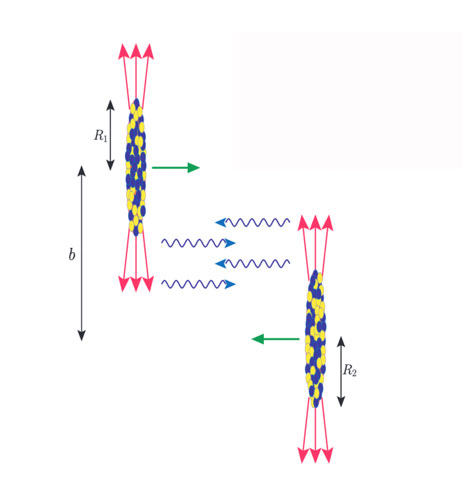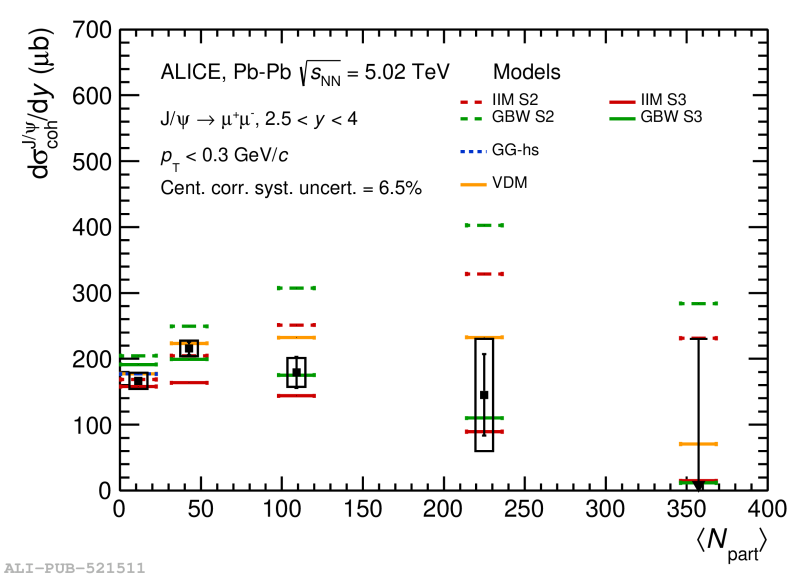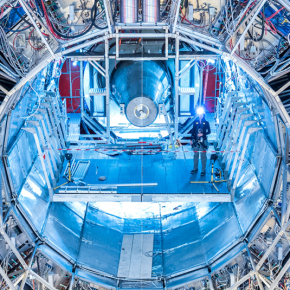LHC: ALICE sheds light on a new type of collision
Among the myriad of protons and lead nuclei collisions at the LHC, other particles are colliding more quietly. These are photon-photon and photon-nucleus collisions. Between 2015 and 2018, the ALICE experiment was able to collect enough data on these very special interactions to draw up an initial portrait of them. The result is a better understanding of the role of gluons in the composition of nuclei and of quantum coherence, and perhaps, in the near future, a new probe of the primordial state of matter that existed a few microseconds after the Big-Bang.
To understand where these colliding photons come from at the LHC, they must be seen as part of the radiation that originates from the intense electromagnetic field of lead nuclei, accelerated to ultra-relativistic energies (99.999993% of the speed of light). This cloud of photons surrounding the lead nuclei has a density of the order of 1024 photons per cm2 at energies of up to a hundred gigaelectronvolts. For the observed interactions to be photon-induced, the nuclei must not 'see' each other, i.e. they must cross each other with an impact parameter (the distance between their centres in the plane transverse to the beams) larger than the sum of their nuclear radii (cf. Figure 1). These are called ultra-peripheral collisions. For impact parameters smaller than the sum of the nuclear radii, the interactions with the photons are indeed superimposed on the hadronic interactions. These interactions are full of lessons for the ALICE experiment.

The measurement of photon-induced reactions is a very interesting complement to the main focus of the scientific programme of the ALICE experiment, which is dedicated to the study of an extreme state of matter, the quark-gluon plasma, that prevailed in the Universe few microseconds after the Big Bang and could exist at the core of neutron stars. One of the key particles for understanding the formation and the properties of this state of matter is a meson called J/psi (consisting of a pair of charm and anticharm quarks), sharing the same quantum numbers as the photon but with a mass approximately three times the one of a proton. The special case where a J/psi is produced not in hadronic collisions but in photon-induced reactions is called photoproduction: a photon acquires mass and is transformed into a J/psi by quantum fluctuation. The ALICE experiment has characterised and isolated this phenomenon for the first time at the LHC energies.
Photon-photon and photon-nucleus interactions with nuclear overlap interest scientists in many ways. They allow us to study fundamental phenomena that have never been observed, in particular by probing nuclei to study the role of gluons in their composition. They also provide a better understanding of the origin of quantum coherence. Finally, in the near future, they may allow us to probe the quark-gluon plasma in a new way and observe purely quantum phenomena such as the destructive interference of photo-generated J/psi, where photons interfere with the two nuclei like light in a Young’s double-slit experiment.
The ALICE detector is particularly optimised to measure these J/psi photoproducts emitted towards the front of the detector, characterised by low momenta (of the order of 60 MeV/c for the transverse component). The J/psi decay products, the muons, are measured by the muon spectrometer, whose design and construction are mainly French.
These optimal experimental characteristics have made it possible to conduct two complementary analyses of the data collected in lead-lead collisions by the collaboration during LHC Run 2, between 2015 and 2018. The first, carried out by researchers at Subatech (Nantes) and IJCLab (Orsay), studies the fraction of photon-hadron interactions responsible for production of J/psi as a function of the number of nucleons involved in the collision (see figure 2). The result, to be published in Physics Letters B, already provides a strong constraint on theoretical models and helps theorists to identify the most promising approaches. A second analysis, which will be published in the coming months and which is carried out by scientists from IP2I (Lyon) in collaboration with the IJCLab (Orsay), studies the polarisation of photo-generated J/psi particles - i.e. the alignment of their spin with their direction - in photon-induced interactions without nuclear overlap.

The next data collected during LHC Run 3 will be crucial: ALICE plans to collect a much larger sample of data, with an upgraded detector put into operation during the last Long Shutdown of the LHC, with faster acquisition electronics and a new tracker placed very close to the collision point, the muon forward tracker or MFT (a project led by IN2P3), which will make it possible to locate the production vertex of the detected J/psi with much greater precision.
